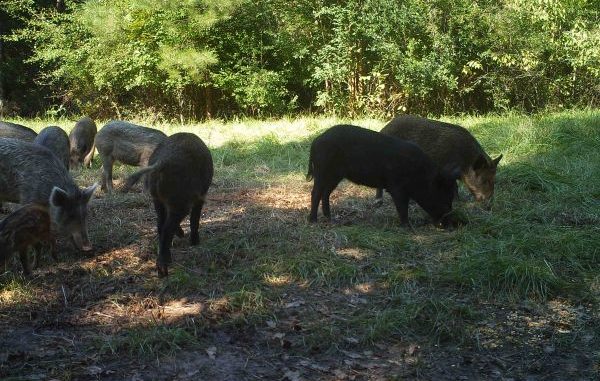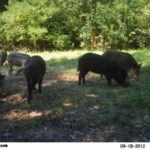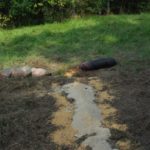
Just when we thought it was time to focus on the 2012 deer season, the pigs decide to keep playing the game.
During the month of July the feral hogs were quite active at Camp David and began coming to the bait sites on a daily basis. I made preparations to shoot them during their daylight visits and at night under the solar lights.
I killed five hogs in July, and by the beginning of August their activity died down and I figured they had had enough of our cat-and-mouse game and had moved on back to the Amite River bottoms.
With the approach of the 2012 deer season it was now time to get things ready and focus on deer.
One activity that we always do on my place and my buddy’s property is to put up cameras on food plots and in the sawtooth oak orchards and see what we have in terms of bucks for the fall. We planted the sawtooth oaks on his property in 1994, and the trees have really started producing acorns on an annual basis. Last year was an exceptional crop, and we documented at least 11 different antlered bucks eating acorns.
This year the crop appeared to be even better, and the acorns started to fall about the middle of August. By the end of August there were at least eight different bucks eating acorns, and the best was yet to come.
Meanwhile, at Camp David, I had set up cameras on the cowpeas and joint vetch, and had also baited a couple of sites with rice bran and had pictures of a couple of bucks.
Unfortunately, Isaac blew into town and made life difficult for many and put the deer season preparations on hold for a couple of weeks. After a couple of weeks of dealing with the issues from the storm, I returned to Clinton to check the cameras in the sawtooth oak orchard.
When I entered the patch where they are located, I was amazed at how much sign there was — animal trails running the entire length of the patch from east to west and a lot of bare ground around the oak trees where animals had been scoffing up acorns. I was thinking this is a lot of deer sign and, while there were still acorns in the trees, the ground was bare of nuts.
It just didn’t add up, and as I went to check the cameras my mind was thinking that the pigs had discovered the nuts. We had photographed a single boar a few weeks back in another food patch, but this was way too much sign for a single hog.
I pulled the card from the first camera and put it in my card reader and saw that there were over 900 photographs on the card. I knew then something was amiss, and I started looking at the pictures.
Initially there were deer photos, but then the deer disappeared and there were pictures of pigs — lots of pigs. Little pigs, big pigs, medium-sized pigs, black pigs, white pigs, red pigs with stripes and so on (somewhat like a Dr. Zeus Book).
I flipped back to look at the latest photos and saw that the pigs had been there yesterday afternoon.
The second camera was a repeat of the first camera.
Our nice deer patch was now Hog City. There were a few photos of deer and turkeys when the hogs were not around. The problem was the benefit that we had hoped to get for the wildlife from this abundant acorn crop was being removed by the pigs.
I called my buddy and told him we needed to make plans to kill some pigs, and plans were made for the attack.
The next Sunday afternoon, four of us were in the turkey box blind located at the patch, awaiting the arrival of our guests for their afternoon foraging. We could hear pigs squealing in the woods, and knew it would not be long before they began arriving. There were still a few acorns on the ground so there was no need to bait.
Suddenly about 10 shots rang out from the neighbor’s property next door. Apparently, they had been seeing the same thing at their feeder they keep going year-round.
Ten minutes later we could hear the sound of animals moving through the dry leaves, somewhat like the wind — but there was no wind; within a few minutes, a herd of 75 or so pigs (the thundering herd we had seen in photos) moved through the woods behind us, about 50 yards away. However, because of the trees we could not shoot.
I thought they might return later in the day, but only a large boar came into the patch and my buddy dropped it with his rifle.
I returned on Monday afternoon and another younger boar, about 125 pounds, came in and I dropped it with my .444.
I watched a spike the next morning feed for a short while. All the acorns were gone, so we decided to bait with corn and see if we could kill a few more hogs before the bow season.
Several more attempts were made but the hogs did not want to cooperate with us. One problem with hogs is that bait needs to be there every day or else they move on to other food. We did not want to put up a feeder at this time, so I would bait about every three or four days.
September was coming to an end, and it was getting time to plant the patches as soon as the soil moisture got right. Based on the cameras, it appeared the hogs liked to come in the early afternoon, so one Thursday I was in the blind by myself and sure enough a nice group of hogs came in and moved right to the bait line. I had started putting out a single line in front of the blind.
The hogs hesitated for a few minutes and then moved right in; the shotgun was in the ready position and when they lined up I cut loose with three shots. When the smoke cleared, two were on the ground. I searched for some blood, but finding none returned to the site and began the chore of hauling out hogs and processing them. Two nice 100-pound porkers.
A few more efforts were made to shoot them again, but with the bow season opening on Monday it was time for the deer season.
Unfortunately the hog activity was suppressing the deer activity.
Meanwhile the hogs had returned to Camp David and, instead of deer on the rice bran, it was pigs doing all of the feeding. The rains came and the first week of October I was busy plowing and putting seed in the ground.
I made my first bow hunt on the evening of Oct. 3. The camera revealed that pigs were coming to the bait around 5 so I was in the stand for 4, and at 4:15 the pigs came in and I proceeded to drill one with my new crossbow.
No doubt this will probably be the trend for us during this deer season until the pigs decide to move to the hardwoods in the drains.
Hopefully, once the winter grass and clover sprout the deer will return to the patches without being interfered with by the hogs. As has been documented, deer and hogs don’t like to mix, and the pig mania we have experienced certainly proves that point.


